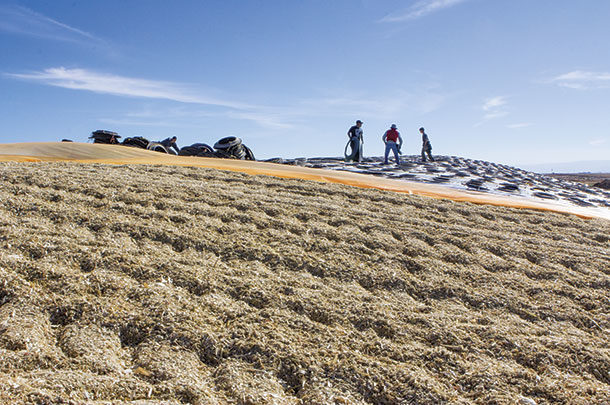Many farms grow their own crops for silage and invest significant amounts of time and money in planting, growing and harvesting those forages. Mistakes made while growing, harvesting and storing silages cannot be rescinded and are costly to replace.
The singular goal of ensiling all forage crops is to preserve them with a relatively high moisture level for future use as feedstuffs for livestock. The ensiling process essentially preserves large amounts of organic matter in an air-free environment and keeps it from spoiling.
The plant material undergoes a fermentation process in which bacteria produce acids that “pickle the pile.” The rapid removal of oxygen and the cessation of respiration through the physical packing of a silo or bunker are critical in producing a well-fermented and stabilized pile of silage.
In most farming regions of the country, corn is the forage primarily ensiled. Corn plants cannot be baled and therefore must be preserved in the form of silage.
In those regions where inclement weather makes it difficult to bale grasses and legumes, ensiling haycrops offers an alternative solution to baling. Grain crops such as oats, barley and rye are commonly ensiled while still in the immature stage as well.
Producing good corn silage is first and foremost dependent upon the proper moisture level of about 68 percent to 72 percent. This range of moisture enables the fermentation process to progress quickly, allowing for the optimal production of lactic acid, which stabilizes and preserves the organic matter.
The quick removal of air from a pile or a silo halts the oxidation and heating that can damage the fiber, protein and starch.
Ensiling grasses and legumes can be more problematic for the farmer due to their lower levels of starch. Hay and small-grain crops are usually ensiled with lower moisture levels – generally between 60 percent to 65 percent. Hay and grain crops harvested with excessive moisture levels are prone to poor fermentation and undesirable acids which can harm animals.
Proper fermentation is all about creating and maintaining an optimum mix of bacteria and moisture that produce a number of acids, the most important of which is lactic acid. Silage acids are the end products of the fermentation process. A properly fermented pile of silage should use up all the air in a matter of a few days, and the heating from oxidation should come to an end.
The ensiling process then switches over to anaerobic fermentation in which bacteria produce large amounts of lactic acid, stabilizing the pile with a pH of about 4 and halting the decaying process of the organic matter. The more rapidly this process occurs, the better the quality and stability of the silage.
Feeds that do not ferment rapidly enough will produce more acetic acid rather than lactic acid. While acetic acid is not harmful, it is not very palatable to the cow, and its excessive presence indicates a slower fermentation and ultimately the undesirable breakdown of organic material to alcohols.
A properly fermented silage should always have more lactic acid relative to acetic – about a 3-to-1 ratio. The unwanted acids, propionic and butyric, should be negligible. The presence of propionic and butyric acids in silage also indicates the fermentation process was not optimal.
The prolonged presence of oxygen in a fermenting pile of forage results in the continued heating and degradation of organic matter. Depending on how hot a pile gets, and how long that heat continues, will alter the quality of protein, making it less available in the cow’s rumen.
Piles that have suffered through extensive heating will have darkened or blackened forage that has lost much of its nutrition. If the temperature in a silo or bunk is in excess of 130ºF, aerobic spoilage will occur.
In extreme cases, especially in haylages put up too wet, butyric acid will be produced from clostridial bacteria. Clostridiums come out of the ground and will flourish in the absence of lactic acid and excessive moisture. Excessive levels of clostridial fermentation and butyric acid can be toxic to cattle. Butyric acid is readily detectable by its foul smell. The addition of a silage inoculant will help keep acetic and butyric acid to a minimum in all types of silages.
Storage and management
The type of silage storage environment must be well planned and should be designed based upon the rate of daily feedout in order to minimize prolonged exposure to air before it’s fed to cattle. Upright silos have the advantage of minimizing air exposure but can be cumbersome to work with. Traditionally, upright silos have worked well for smaller herds.
Larger herds can make good use of horizontal piles, pits and plastic bags. However, these require a much more extensive level of management both in terms of covering and protection from weather and the amount of silage exposure as the silage is fed out.
Piles should be sized so the face can be removed to a depth of 6 inches or more every day if possible. Once silage is re-exposed to air, it will experience a secondary fermentation and heating, and the quality will rapidly decrease. All organic matter begins to decay immediately upon re-exposure to air.
Silages in silos or bunkers that are well sealed will remain stable for months and years. In order to ensure that fermentation is optimal and the silage will retain its nutritional quality, the process of packing a bunk or filling a silo is crucial. Forages intended for ensiling must be:
- Packed quickly
- Packed tightly
- Tightly sealed against air penetration
Packing silage to a density of at least 45 pounds per cubic foot is critical to both forcing out air during harvest and slowing down air penetration once a face has been exposed. On a dry matter basis, this means:
- 30 percent dry matter corn silage = 13.2 pounds dry matter per cubic foot
- 40 percent dry matter haylage = 17.6 pounds dry matter per cubic foot
Silos and bunkers must eventually be opened to allow access. The door is then opened for aerobic spoilage, and the dairy farmer must aggressively manage the exposed silage on a daily basis to minimize spoilage. No matter how well forage has been ensiled, the best corn and haycrops can be quickly ruined with poor bunk face management.
Silage pile faces left exposed and untouched for many days soon show signs of decay, and the nutritional value of the organic matter is quickly lost as yeasts begin to grow on the forage.
Specific strains of yeast that consume lactic acid are the primary initiators of anaerobic spoilage. Ragged and uneven ledges left on a silage face also create more surface area to be exposed to the air.
Manage the feeding face to minimize aerobic spoilage:
- Remove sufficient silage each day to prevent spoilage – 6 to 12 inches per day.
- Remove more in hot weather and for drier and poorly packed silages.
- Keep the silage face clean and minimize face damage; a mechanical silage facer can help.
- Knock down only enough silage to feed in a day.
- Avoid leaving large piles of silage at the base of the face for extended periods of time.
Silage inoculants such as weak organic acids and bacterial additives are a proven way to both improve fermentation at the time of harvesting as well as reduce the severity of anaerobic spoilage after silage has been re-exposed to air.
All silages can benefit to some degree with the addition of an inoculant. Grass and legumes, which are more inclined toward poor fermentation profiles, should always be harvested with the addition of an inoculant.
Other silages and management scenarios that may benefit from silage additives include:
- High-moisture corn
- Small-grain silages
- Silages with low moisture
- Silage fed during warm weather
- Silages fed out slowly
- Silage that will be moved between silos
- Silage fed from intermediate feeding piles
Ensiling forages is certainly not new technology; it’s been around for a long time. Today’s modern dairy and beef farmers can reduce purchased feed costs with the production of high-quality forages.
However, they must focus on producing and managing their silages to minimize organic and dry matter losses, poor fermentation and spoilage and regard those silages as a superior source of digestible fiber and nutrition for their herds. ![]()
PHOTO: The question isn’t how much silage you make, but how much you lose through mismanagement. Harvest management and storage will determine the nutrients you keep, as opposed to those you have to buy. Photo by Mike Dixon.

-
John Hibma
- Consulting Ruminant Nutritionist
- South Windsor, Connecticut
- Email John Hibma











